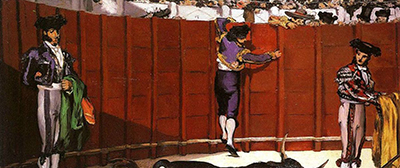The Bullfight is one of many depictions of a bullfight event painted by Manet. This particular bullfighting scene was completed in 1864 as an oil on canvas painting.
It is held in New York's Frick Collection. Manet was drawn to the visceral qualities of the bullfight and its spectators, fascinated by the energy and movement of light and the juxtaposition between movement and stillness.
However, upon being exhibited at the Paris Salon in 1856 it was negatively appraised by a number of critics. This effected Manet so much that he cut his canvas in half with a sharp knife.
The Bullfight painting would have constituted the upper portion of the original painting. A dead toreador surrounded by shadow would have featured in the original bottom portion of this image.
The two halves were later reworked by Manet to become what we know of the two individual paintings today: The Bullfight and The Dead Toreador.
The Bullfight itself is painted in a realist style but with splashes of colour in the audience that would later become a major influence for Manet's move toward Impressionism. The direct influence on Manet's The Bullfight was a trip to Spain in 1856 where he witnessed his first bullfight. Picasso also famously captured Bullfighting in several paintings and sketches.
Bullfighting had been performed in travelling exhibitions to Paris in the past and was a frequent topic for writing, but it was banned by France's Second Empire for its cruelty in Manet's time. Manet produced this painting entirely from memory and, as with his other bullfighting scenes, attempted to draw attention to the heroic stance bullfighters understood of themselves over what Manet saw as a brutal and absurd public spectacle.
Manet studied under the famed painter Thomas Couture from 1850 to 1856; he opened his own studio in 1856 and adopted a Realist style in his paintings.
Although his work in the realist style received widespread acclaim at the Paris Salon, it is his transition toward Impressionism which became his decisive accomplishment.
Impressionism largely rejected many traditional realist elements, drawing on a subjective and temporal understanding of light, tone, colour and form. Manet's Cafe scenes in particular incorporated aspects and perspectives of the Parisian flâneur (stroller) into painting.




